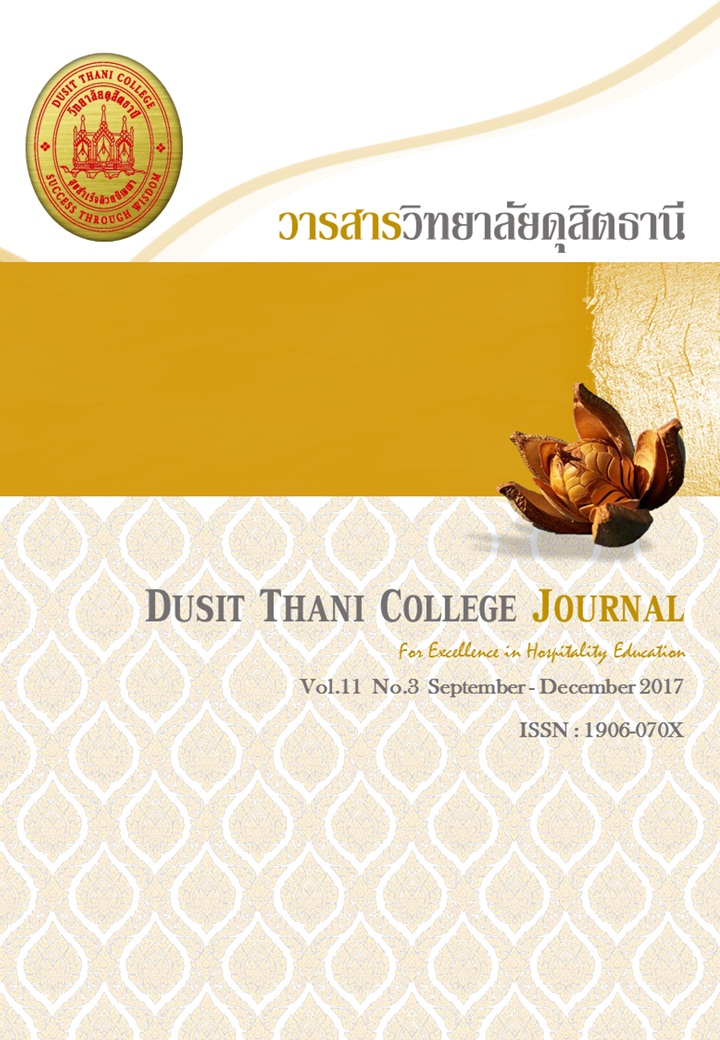การติดสมาร์ทโฟนของนักศึกษา : การพัฒนาแบบวัดในบริบทนักศึกษาปริญญาตรี ในกรุงเทพมหานคร
Main Article Content
บทคัดย่อ
การวิจัยนี้มีวัตถุประสงค์เพื่อพัฒนาแบบวัดการติดสมาร์ทโฟนให้เป็นแบบวัดที่มีคุณภาพเที่ยงตรงและเชื่อถือได้ กลุ่มตัวอย่าง คือ นักศึกษาปริญญาตรีในกรุงเทพมหานคร จำนวน 986 คน เก็บข้อมูลด้วยแบบวัดการติดสมาร์ทโฟน จำนวน 30 ข้อ ซึ่งได้รับการตรวจสอบความเที่ยงตรงเชิงเนื้อหาจากผู้ทรงคุณวุฒิ และมีค่าความเชื่อมั่นทั้งฉบับเท่ากับ 0.94 ผลการศึกษาโดยการวิเคราะห์องค์ประกอบเชิงยืนยันอันดับสอง พบว่า การติดสมาร์ทโฟนประกอบด้วย 6 องค์ประกอบ คือ การให้ความสำคัญ การเปลี่ยนแปลงทางอารมณ์ การสูญเสียการควบคุม การเลิกหรือหยุดใช้ การขัดแย้ง และการกลับคืนสู่สภาพเดิม และได้แบบวัดจำนวน 24 ข้อ มีความเที่ยงตรงเชิงเสมือนและมีความเชื่อมั่นในการวัดตัวแปรแฝงในระดับที่เชื่อถือได้ โดยมีค่าเฉลี่ยของความแปรปรวนที่ถูกสกัดได้อยู่ระหว่าง 0.52 - 0.79 และมีค่าความเชื่อมั่นในการวัดตัวแปรแฝงอยู่ระหว่าง 0.79 - 0.93
Article Details
นโยบายการพิจารณากลั่นกรองบทความ
- บทความวิจัยและบทความวิชาการทุกเรื่องที่จะได้รับการตีพิมพ์ต้องผ่านการพิจารณากลั่นกรองโดยผู้ทรงคุณวุฒิ (Peer Review) ในสาขาที่เกี่ยวข้อง จำนวน 3 ท่าน/บทความ
- บทความ ข้อความ ภาพประกอบและตารางประกอบที่ลงตีพิมพ์ในวารสารเป็นความคิดเห็นส่วนตัวของผู้เขียน กองบรรณาธิการไม่จำเป็นต้องเห็นด้วยเสมอไป และไม่มีส่วนรับผิดชอบใด ๆ ถือเป็นความรับผิดชอบของผู้เขียนแต่เพียงผู้เดียว
- บทความที่จะได้รับการตีพิมพ์จะต้องไม่เคยตีพิมพ์ เผยแพร่ที่ใดมาก่อน และไม่อยู่ระหว่างการพิจารณาของวารสารฉบับอื่น หากตรวจสอบพบว่ามีการตีพิมพ์ซ้ำซ้อน ถือเป็นความรับผิดชอบของผู้เขียนแต่เพียงผู้เดียว
- บทความใดที่ผู้อ่านเห็นว่าได้มีการลอกเลียนหรือแอบอ้างโดยปราศจากการอ้างอิง หรือทำให้เข้าใจผิดว่าเป็นผลงานของผู้เขียน กรุณาแจ้งให้กองบรรณาธิการวารสารทราบจะเป็นพระคุณยิ่ง
เอกสารอ้างอิง
of Psychiatric and Psychological Views. Int J Prev Med. 3 (4): 290-294.
Blanchi, A. & Phillips, J. G. (2005, February). Psychological Predictors of Problem Mobile
Phone Use. CyberPsychology & Behavior. 8(1): 39-51.
Bolle, C. (2014). “Who is a smartphone addict?” The impact of personal factors and
type of usage on smartphone addiction in a Dutch population. Netherlands:
University of Twente.
Griffiths, M. D. (1995). Technological addictions. Clinical Psychology Forum. 76 (1): 14-19.
. (2005). A ‘components’ model of addiction within a biopsychosocial
framework. Journal of Substance Use. 10 (4): 191-197.
Hair, J. F. et al. (2010). Multivariate data analysis: a global perspective. (7th ed.). Upper
Saddle River, NJ: Prentice-Hall.
Kline, R. B. (2005). Principles and Practice of Structural Equation Modeling with the SIMPLIS Command Language. 2nd ed. Chicago, IL: Scientific Software International, Inc.
Kwon, M. et al. (2013). Development and Validation of a Smartphone Addiction Scale (SAS). PLoS ONE. 8(12): 1-7.
Merlo, L. J., Stone, A. M., & Bibbey, A. (2013). Measuring Problematic Mobile Phone Use:
Development and Preliminary Psychometric Properties of the PUMP Scale. Journal
of Addiction. 2013: 1-7.
National Statistical Office. (2016). The 2016 Household Survey on the Use of Information and Communication Technology. Retrieved April, 3 2016, from
https://service.nso.go.th/nso/web/survey/surtec5-1-3.html. (in thai)
Office of Higher Education Commission. (2016). Higher Education Institution affiliated
with Higher Education Commission. Retrieved June, 1 2016, from https://www.mua.
go.th/ohec/Department.html. (in thai)
Phachongchit Phapoom. (2003). Computer/Internet Addiction: Prevention and Intervention.
Journal of Mental Health of Thailand. 11(1): 42-54. (in thai)
Rovinelli, R. J. & Hambleton, R. K. (1976). On the Use of Content Specialists in the
Assessment of Criterion-Referenced Test Item Validity. Retrieved April, 2 2016, from https://files.eric.ed.gov/fulltext/ED121845.pdf
Salehan, M. & Negahban, A. (2013). Social networking on smartphone: When mobile
phone become addictive. Computers in Human Behavior. 29: 2632-2639.
Schumacker, R. E. & Lomax, R. G. (2010). A Beginner’s Guide to Structural Equation
Modeling. 3rd ed. New York: Taylor and Francis Group, LLC.
Suwimol Tirakanan. (2008). Creating a Variable Measurement Tool in Social Science
Research: A Practical Guide. 2nd ed. Bangkok: Chulalongkorn University Press.
Sucheera Phattharayuttawat. (2002). Manual of Psychological Testing. Bangkok: Medical Media.
Walsh, S. P., White, K. M., & Young, R. M. (2008). Over-connected? A qualitative exploration
of the relationship between Australian youth and their mobile phones. Journal of
Adolescence. 31(1): 77-92.
. (2010). Needing to Connect: The Effect of Self
and Others on Young People’s Involvement with their Mobile Phones. Australian
Journal of Psychology. 62(4): 194-203.
Young, K. S. (1999). Internet addiction: Symptoms, Evaluation, And Treatment. Innovations
in Clinical Practice. Retrieved January 10, 2015, from https://netaddiction.com/
articles/symptoms.pdf


